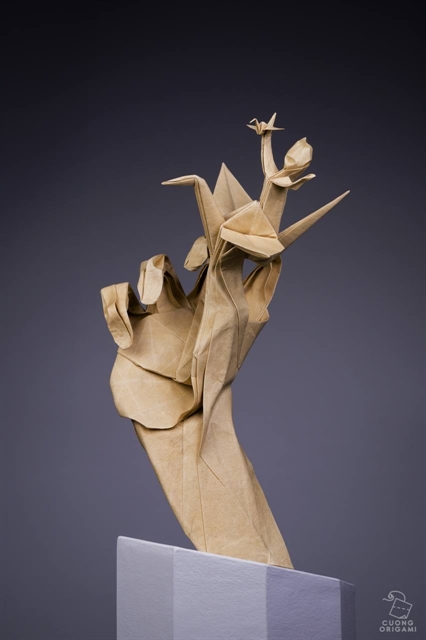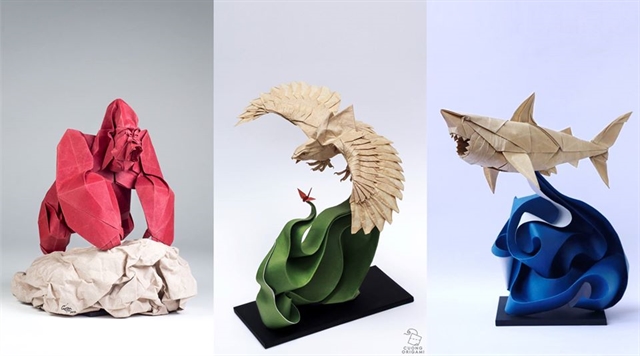 Features
Features

When his parents gave him a book that taught him how to fold paper into dinosaurs and other prehistoric creatures at the age of seven, Nguyễn Hùng Cường found his passion – origami.

|
| Fly High, Dreamers!, one of Cường's favourite origami artworks. Photo coutesy of Nguyễn Hùng Cường |
By Lương Thu Hương
When his parents gave him a book that taught him how to fold paper into dinosaurs and other prehistoric creatures at the age of seven, Nguyễn Hùng Cường found his passion – origami.
Cường created his first origami work when he was 10 and it was those first creations, despite their simplicity, that have driven him to pursue the art until now.
Since those simple initial folds, the 30-year-old man has created many elaborate origami works that have been praised by prestigious international publications like Huffington Post, and ABC News.
His creation Gorilla was praised by renowned origami artist Robert J Lang at an exhibition held by Origami USA.
The former student of Hà Nội University of Science and Technology was also the runner-up of an online international origami contest 2009.
Cường says his inspiration for his artworks can come from everywhere, from what he hears, reads and feels.

|
| Cường is the author of about 200 origami designs. |
“Surrounding us are many beautiful things that we have our own way of perceiving. Therefore, I want to demonstrate my feelings about the surrounding world with the language that I’m most confident with – origami,” the Hà Nội-based creator says
“I have been interested in observing animals, their shapes and movements since I was small, so most of my creations are related to animals.
"I like focusing on their eyes. To each animal, I challenge myself by folding their eyes in different ways and try to make them as lively as possible.”
One of the things that differentiate his artworks from others is the use of traditional dó (poonah) paper. Cường started to use the material in 2009. The paper is thin and durable but has not been favoured among other origami creators due to its softness. His first works created from the paper were therefore very soft.
By 2012, he adapted poonah paper by applying a thin layer of glue to its surface, making it stiffer and better at holding the folds.
“I read about the technique after reading books by many international authors," Cường says.
"The treated dó paper allows me to create more beautiful, better-shaped works compared with other kinds of industrial paper that I have tried, so most of my contemporary creations have been made from dó paper.
“Another reason why I chose dó paper was because I want to enhance the value of Vietnamese traditional paper. Many origami creators, from both Việt Nam and abroad, want to experiment with dó paper after seeing my work.”
According to Cường, the folding process includes four steps – visualising ideas, designing, preparing paper and realising the ideas into works.
“To create a ‘soulful’ work, the creator must have years of training, combined with knowledge from various fields to make proper folds," Cường says.
“It demands a lot of practice to hone the skillfulness of the hands to be most effective,” he adds.
It normally takes him one to two months to create satisfactory artworks, of which the designing stage takes the longest as he has to constantly experiment with various folding methods.
The origami creator sometimes wants to renovate his old designs, meaning that in some cases, a work might take years to be finalised.
One of Cường’s recent is Fly High, Dreamers!, which portrays a hand holding a crane carrying a boy holding another small crane in his hand.
“Folded from a single square paper without any cuts, the work manifests a tribute to predecessors who have become the launchpad for the next generations to fly high with their dreams.
"The figure of the crane is often associated with dreams; the big hand represents the predecessors supporting the dream of the boy – the contemporary young generations, and to his turn, the boy continues to support the dreams of the next generations,” Cường explains.
Fly High, Dreamers! was displayed in Paper Heroes exhibition held in Jaffa Museum in Tel Aviv, Israel in 2017.
“I consider the origami predecessors as my heroes who have led me to the art, showing me how wonderful it is and bringing me much knowledge. I have always been grateful to them and told myself to continue to pass the fire of passion to the next generations.”
Recently, 13 of Cường's works made with traditional dó paper were displayed during Loài Plastic (Plastic Species) exhibition held in Hà Nội and HCM City. The exhibition aimed to raise public awareness about the overuse of plastic products, particularly disposable ones.
“I hope that my works, made from environmentally-friendly material, will showcase my efforts in minimalising the use of the materials, not only plastic, which are harmful to the environment," he says.
"Next, my creations are expected to arouse the audience’s curiosity about the environmental issue and therefore they will consider the environment before using any product.”
Cường has quit his job as an engineer to totally focus on origami.

|
| OLD MEETS NEW: Some of Cường's origami works made from Việt Nam's traditional dó paper. Photos courtesy of Nguyễn Hùng Cường |
He admits that earning money from the art is not easy but he considers it an initial challenge on his new path.
“Origami artworks have not yet been appreciated as paintings or sculptures by art specialists. Meanwhile, few artists or sculptors have achieved success and managed to learn on the job; therefore, becoming an origami artist and living on the art is very difficult," he said.
To earn more money, Cường has participated in many commercial projects using origami artworks, writing books and teaching origami in events, which has earned him enough to support his creativity.
Up to now, he has created about 200 origami designs. Together with other friends from the Việt Nam Origami Group, he has written three books about the art that were published abroad and expects to have more books released in Việt Nam soon.
“I have no specific secrets,” Cường reveals.
“If you have passion in anything, study it a lot and train hard to develop your expertise, in addition to studying about other fields related to your concern like maths, physics or sculpture or even history or biology. Such knowledge seems to be unrelated but if it is utilised skillfully, it will be very helpful in pursuing your path, he says.
“I also hope to inspire others to study about other traditional Vietnamese kinds of paper, besides dó paper, which are also facing oblivion. We should join hands in preserving and developing the precious papers of the country.” VNS




